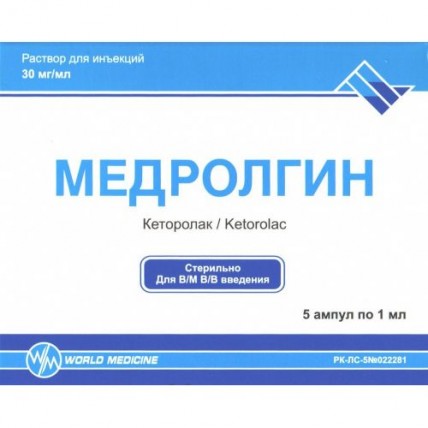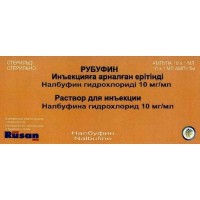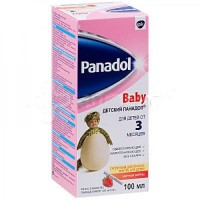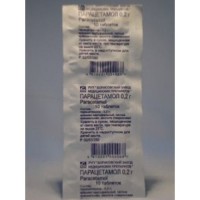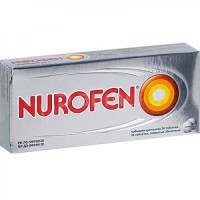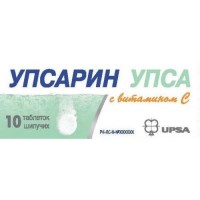Medrolgin 30 mg / ml 1ml 5's solution for injection in ampoules
- $17.10
The instruction for medical use of MEDROLGIN medicine the Trade name Medrolgin Mezhdunarodnoye the unlicensed name Ketorolak Lekarstvennaya a form Solution for intramuscular and intravenous administration, 30 mg/ml the Description Transparent colourless or pale yellow color solution Structure 1 ampoule of drug contains active agent - ketorolak trometamol 30 mg, excipients: dinatrium edetat, ethanol of 96%, sodium chloride, sodium hydroxide, 10% solution of sodium of hydroxide or 10% Acidum hydrochloricum, water for injections. Pharmacotherapeutic group Anti-inflammatory and antirheumatic drugs. Nonsteroid antirheumatic drugs. Acetic acid derivatives. Ketorolak. The pharmacological Pharmacokinetics Later properties of intramuscular introduction ketorolak it is quickly and completely soaked up from the place of an injection in a system blood stream. Average maximum plasma concentration of 2.2 mkg/ml is reached, on average, in 50 minutes after intramuscular introduction of a single dose of 30 mg. At single intravenous administration the peak concentration in plasma are reached within 1-3 minutes. Linking with proteins of plasma makes 99%. At physiological values rn the ketorolaka trometamol is present at the dissociated form. More than 50% of the entered dose are metabolized in a liver with formation pharmacological of inactive metabolites. The main metabolites are glucuronides and p-hydroksiketorolak. Ketorolak and his metabolites are removed mainly with urine (91%) and to a lesser extent with a stake (6%). Elimination half-life at patients with normal function of kidneys averages 5.3 hours. Ketorolak's pharmacodynamics trometamol is non-steroidal anti-inflammatory drug which has analgetic, anti-inflammatory and febrifugal activity. The mechanism of action is connected with non-selective oppression of activity of TsOG-1 and TsOG-2 enzymes, mainly in peripheral fabrics, slowing down of biosynthesis of prostaglandins - modulators of painful sensitivity, thermal control and inflammation is a consequence of what. The biological activity of a ketorolak of a trometamol is connected with a S-form. Ketorolaka trometamol does not influence opioid receptors, breath does not oppress, does not cause medicinal dependence, does not possess sedative and anxiolytic action. On force of analgeziruyushchy effect it is comparable to morphine, considerably exceeds other NPVS. The maximum analgetic effect of a ketorolak is reached within 2-3 hours, duration of an analgesia is 4-6 hours. The analgetic dose of a ketorolak has also anti-inflammatory effect. Indications Treatment has to be begun only in the conditions of a hospital. The maximum duration of treatment is no more than two days. - a pain syndrome of average and strong intensity of various genesis (including pains in the postoperative period, in oncological diseases). A route of administration and doses Solution for intramuscular and intravenous administration. Intravenous administration of Medrolgin has to continue not less than 15 seconds. Intramuscular introduction of Medrolgin needs to be carried out slowly in the form of a deep intramuscular injection. It is possible to avoid local side reactions by use of pressure in the place of an injection within 15-30 seconds after introduction. Contraindicated epidural and intrathecal administration of drug. The recommended Medrolgin's dose for stopping of moderately heavy and acute pain at adults makes 10 and 30 mg for intramuscular or intravenous administration respectively, each 6 hours. The maximum daily dose should not exceed 90 mg. To patients with body weight less than 50 kg or are more senior than 65 years, or with a mild renal failure it is necessary to enter once 30 mg of a ketorolak of a trometamol intramusculary or 15 mg of a ketorolak of a trometamol intravenously. The maximum daily dose should not exceed 60 mg. The maximum duration of treatment should not exceed 2 days. Side effects - a round ulcer, perforation or gastrointestinal bleeding sometimes fatal (especially at people of advanced age), nausea, dyspepsia, gastrointestinal pain, sensation of discomfort in a stomach, a hematemesis, gastritis, an esophagitis, diarrhea, an eructation, a constipation, a meteorism, feeling of overflow of a stomach, a melena, rectal bleeding, a stomacace, vomiting, hemorrhage, pancreatitis, exacerbation of colitis and Crohn's disease - uneasiness, a disorder of vision, an optic neuritis, drowsiness, dizziness, a headache, the increased perspiration, dryness in a mouth, nervousness, paresthesia, a depression, euphoria, spasms, the increased thirst, inability to concentrate, insomnia, an indisposition, increased fatigue, excitement, vertigo, disturbance of flavoring feelings and sight, myalgia, unusual dreams, confusion of consciousness, a hallucination, a hyperkinesia, a hearing loss, a ring in ears, aseptic meningitis with the corresponding symptomatology, psychotic reactions, disturbances of thinking - the increased urination frequency, an oliguria, an acute renal failure, a hyponatremia, a hyperpotassemia, a hemolytic uraemic syndrome, the increased content of urea and creatinine in blood serum, interstitial nephrite, an ischuria, a nephrotic syndrome, a renal failure - an abnormal liver function, hepatitis, jaundice and a liver failure - rushes of blood to the person, bradycardia, pallor, arterial hypertension, palpitation, thorax pain, hypostases, heart failure Data of clinical and epidemiological trials demonstrate that use of some NPVS, especially in high doses and the long time, can be associated with the increased risk of development of arterial tromboembolic episodes (myocardial infarction or a stroke). - short wind, asthma, a fluid lungs - a purpura, thrombocytopenia, a neutropenia, an agranulocytosis, aplastic and hemolytic anemia, post-operational hemorrhages, hematomas, epistaxis, bleedings, lengthening of a bleeding time - an itching, urticaria, photosensitivity of skin, a Lyell's disease, bullous reactions, including Stephens-Johnson's syndrome and a toxic epidermal necrolysis (very seldom), exfoliative dermatitis, makulopapulezny rashes - nonspecific allergic reactions, an anaphylaxis, asthma, deterioration in a course of asthma, a bronchospasm, a laryngeal edema or short wind, rash, an itching, urticaria, a purpura, a Quincke's disease and in single cases - exfoliative and bullous dermatitis (including an epidermal necrolysis and a multiformny erythema) - female infertility - hypostases, increase in body weight, fervescence. Contraindications - hypersensitivity to a ketorolak or any component of drug - GIT erosive cankers in an aggravation phase, a round ulcer, gastrointestinal bleedings in the anamnesis - the bronchial asthma, rhinitis, a Quincke's disease or a small tortoiseshell called by use of acetylsalicylic acid or other non-steroidal anti-inflammatory drugs - bronchial asthma in the anamnesis - the period to and during surgery - heavy heart failure - a full or partial syndrome of nasal polyps, a Quincke's edema or a bronchospasm - surgeries with high risk of hemorrhage or an incomplete stop of bleeding - intake of anticoagulants - a liver failure or a moderate and heavy renal failure (creatinine of blood serum is more than 160 µmol/l) - the suspected or confirmed cerebrovascular bleeding, hemorrhagic diathesis, including disturbance of fibrillation and high risk of bleeding - simultaneous treatment by other non-steroidal anti-inflammatory drugs (NPVS) (including selection inhibitors of cyclooxygenase), acetylsalicylic acid, warfarin, a pentoxyeagle owl, probenetsidy or lithium salts - a hypovolemia, dehydration - the period of pregnancy, pains, childbirth and feeding by a breast - children's age up to 16 years. Medicinal interactions Simultaneous treatment by other non-steroidal anti-inflammatory drugs (including selection inhibitors of cyclooxygenase), acetylsalicylic acid contraindicated because of the increased risk of development of side effects. Joint reception of a ketorolak of a trometamol with oral anticoagulants, antiagregant, heparin for system use, thrombolytic means increases risk of bleeding. Simultaneous use of a ketorolak of a trometamol and probenetsid is contraindicated. NPVS increase concentration of lithium in plasma due to decrease in renal excretion of lithium. Concentration of lithium in plasma can reach toxic values. Combined use of lithium and NPVS is not recommended. Simultaneous use of a ketorolak of a trometamol and a pentoxyeagle owl increases risk of developing of bleeding. NPVS, including a ketorolak trometamol, should not appoint within 8-12 days after mifepristone use as NPVS can weaken effects of mifepristone. Ketorolak is capable to reduce natriuretic effect of furosemide and tiazid. At a concomitant use of a ketorolak and diuretics the increase in risk of developing a renal failure therefore it is necessary to control carefully patients regarding emergence of symptoms of a renal failure is possible and also to make sure of efficiency of diuretic drugs. It is necessary to be careful at the accompanying reception of NPVS, including ketorolak, together with a methotrexate. Simultaneous use of APF inhibitors increases risk of developing renal failures, in particular at patients with the reduced volume of intercellular liquid. NPVS can weaken hypotensive effect of APF inhibitors that should be considered when assigning NPVS together with APF inhibitors. It was reported about isolated cases of developing of spasms during simultaneous use of a ketorolak of a trometamol and anticonvulsants (Phenytoinum, carbamazepine). At simultaneous use of a ketorolak and psychotropic drugs (fluoxetine, a tioteksen, an alprazolam) it was reported about developing of hallucinations. With care it is necessary to appoint at the same time cyclosporine and NPVS, including a ketorolak trometamol, because of the increased risk of emergence of nephrotoxic action. With care it is necessary to appoint at the same time corticosteroids and NPVS, including a ketorolak trometamol, because of the increased risk of developing of gastrointestinal bleeding. At a concomitant use of ftorkhinolon and the ketorolaka of a trometamol can raise risk of developing of spasms. Ketorolak and other NPVS weaken hypotensive action of beta-blockers. Simultaneous use of NPVS with a zidovudine leads to increase in risk of hematologic toxicity. There is an increased risk of a hemarthrosis and hematoma at the HIV-positive people having hemophilia at simultaneous treatment by a zidovudine and ketorolaky. Pharmaceutical interaction Solution for injections should not be mixed in one syringe from morphine sulfate, promethazine and Hydroxyzinum because of loss of a deposit. Pharmaceutical it is incompatible with solution of a tramadol, lithium drugs. The special instructions Probability of Emergence of Side Effects can be minimized, applying the smallest effective dose during the shortest period necessary for elimination of symptoms. The combined use of a ketorolak of a trometamol intramusculary and orally at adult patients should not exceed 5 days. To women who cannot become pregnant and in this regard undergo inspection, use of a ketorolak of a trometamol should be cancelled. Women with reduced ability to fertilization should avoid Medrolgin's use. Ketorolaka trometamol is capable to cause heavy side reactions from a digestive tract. The risk of appearance of gastrointestinal bleedings, serious from the clinical point of view, is dose-dependent. Except existence in the anamnesis of a peptic ulcer, provocative factors is simultaneous use of oral corticosteroids, anticoagulants, long-term therapy by non-steroidal anti-inflammatory drugs, smoking, consumption of alcoholic beverages, advanced age and ill health in general. To patients from risk group appoint an alternative type of therapy which does not include non-steroidal anti-inflammatory drugs. Patients with mild disturbance of renal function have to receive low doses of a ketorolak (no more than 60 mg a day intramusculary). Careful control of function of kidneys is necessary. At the accompanying reception of a ketorolak of a trometamol at patients who receive anticoagulating therapy the risk of developing of bleeding can increase. Ketorolak suppresses aggregation of thrombocytes and prolongs a bleeding time. At patients with normal function of bleeding its time increased, but did not exceed the normal range which is 2-11 minutes. Ketorolaka trometamol appoint to patients with uncontrollable arterial hypertension, the stagnant heart failure established by coronary heart disease, diseases of peripheral arteries and/or vessels of a brain only after careful assessment of a ratio risk advantage. trometamol patients should appoint Ketorolak with care with an abnormal liver function or diseases of a liver in the anamnesis. Treatment of a ketorolak trometamoly can cause increase in levels of liver enzymes that at the existing dysfunction of a liver can cause development of heavier hepatic reactions. Ketorolak cancel in case of clinical symptoms of development of a disease of a liver or system manifestations (for example, an eosinophilia, rash). Use in pediatrics drug Use by children aged up to 16 years contraindicated. Pregnancy and the period of a lactation Use of drug during pregnancy and a lactation is contraindicated. The feature influence of medicine on ability to run the vehicle or potentially dangerous mechanisms When developing dizziness, drowsiness, a disorder of vision, headache, vertigo, insomnias or depressions during reception of a ketorolak of a trometamol to the patient should refuse driving of motor transport and control of mechanisms. Overdose Symptoms: the slowed-down state, drowsiness, nausea, vomiting, pain in epigastric area, gastrointestinal bleeding, arterial hypertension, an acute renal failure, respiratory depression and a coma. Development of anaphylactoid reactions is possible. Treatment: therapy symptomatic and supporting. Specific antidote is absent. A form of release and packing On 1 ml of drug in ampoules from glass. On 5 ampoules put in blister strip packaging. On 1 planimetric packing together with the instruction for medical use in the state and Russian languages place in a box of cardboard. To Store storage conditions in the place protected from light at a temperature not above 25ºС. To store out of children's reach! 3 years not to apply a period of storage after an expiration date. Prescription status According to the prescription the Owner of a trademark and the certificate of registration is the "UORLD MEDITSIN ILACH SANAYI VE TIDZHARET LIMITED of SHIRKETI" company, TURKEY ('WORLD MEDICINE İLAÇ SANAYİ VE TİCARET LİMİTED ŞİRKETİ', TURKEY). Producer "FarmaVizhn Sanayi ve A.Sh. Tidzharet", Turkey (Davutpasha Dzhaddesi No. 145, Topkapy / Istanbul) 'PharmaVision Sanayi ve Ticaret A.Ş.', Turkey (Davutpaşa Caddesi No. 145, Topkapı/İstanbul). The owner of the registration certificate is the "UORLD MEDITSIN ILACH SANAYI VE TIDZHARET LIMITED of SHIRKETI" company, TURKEY the Address of the organization accepting in the territory of the Republic of Kazakhstan claims from consumers on quality of products of RIN Pharm LLP, RK, Almaty, Turksibsky district, the ave. Suyunbaya, 222 the Address of the organization responsible for post-registration observation of safety of medicine of TROKA-S PHARMA LLP acting through Toleuisheva Sandugash, Almaty, Suyunbaya Avenue 222-b
to Develop
to Develop
